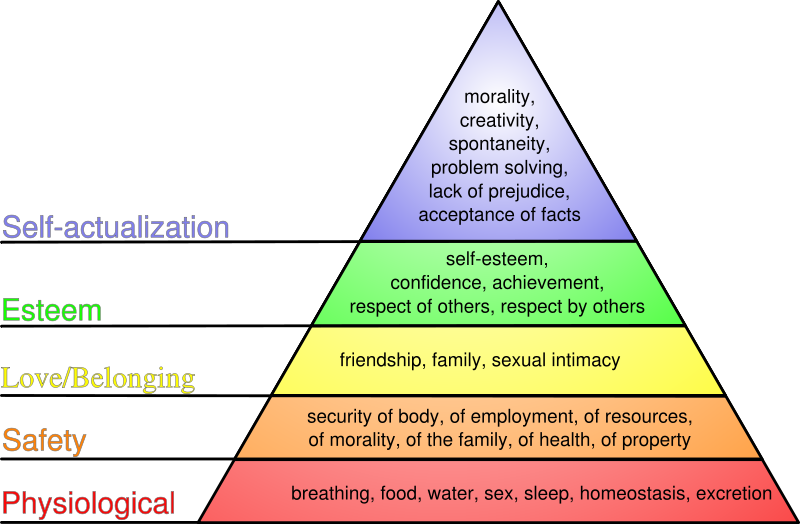Most of our decisions are a result of intrinsic motivations that we have through our day to day life. Some we are aware of and many appear to affect us on a deep unconscious level. These motivations and needs can be the desire to eat and be healthy, to the desire to look good and be accepted by our peers. In 1943 Abraham Maslow proposed a theory of human motivation that he placed into a hierarchy with basic physiological needs such as breathing, food and water that are needed for survival at the bottom of the structure to self actualization, and self esteem at the top.

This diagram can prove helpful in understanding the importance of motivation when making decisions for a given situation. The real value for design in this diagram is that when planning a new product or promotional piece, then you are more able to think clearly about what needs you may be addressing and how important they are to the individual. Very often you want a new product to solve a particular problem, and that may be a motivation lower on the needs hierarchy suggesting it is fundamental desire of many to be healthy for example, but then you want to attach aspiration imagery and language that appeals to a higher need for a product to allow the user to achieve a higher level of creativity or self esteem. The concepts Maslow put forward are guides to the things that are important to us, after the basic needs are met it is important to understand the importance of the higher needs for us to ultimately become more self fulfilled and reach a transcendent state of being. The goal of reaching all that you can be is the concept in this diagram, once all things lower in the hierarchy are resolved then you can become yourself. The concept has received criticism about being very ethnocentric, as it doesn't express the differences of social and intellectual needs for those born into individualistic society and those raised in a collectivist society, where the acceptance and community will outweigh the needs for freedom and individuality. It is most definitely about the individual, which makes sense considering Maslow was from the United States and lived in an individualistic society. None the less it does give a insight into some motivations of people and especially consumers from many parts of the World that are mostly looking for self fulfillment. The flow from survival, comfort and psychological needs into self actualization and transcendence is an important part of understanding the motivations we have in given situations, it also goes a long way to explaining some of our habits and how external influences can affect our decisions. Also, as you browse the hierarchy of the diagram, you see how friendship, family and respect have lead to such social networking sites as facebook and twitter not to mention how blogging itself is helping in our need for creativity and self actualization.
Manfred Max-Neef argued against this concept and put forward an extension of human needs that looks more like this table below, Max-Neef believed that there is no hierarchy of needs but rather trade offs towards satisfaction. He also suggested that our needs are few, finite and classifiable and not like Maslow whose hierarchy suggests the needs are infinite and insatiable. Max-Neef argues that poverty for example, may result from any of these needs being denied or unfulfilled.
| Need | Being (qualities) | Having (things) | Doing (actions) | Interacting (settings) |
|---|---|---|---|---|
| subsistence | physical and mental health | food, shelter, work | feed, clothe, rest, work | living environment, social setting |
| protection | care, adaptability, autonomy | social security, health systems, work | co-operate, plan, take care of, help | social environment, dwelling |
| affection | respect, sense of humour, generosity, sensuality | friendships, family, relationships with nature | share, take care of, make love, express emotions | privacy, intimate spaces of togetherness |
| understanding | critical capacity, curiosity, intuition | literature, teachers, policies, educational | analyse, study, meditate, investigate, | schools, families, universities, communities, |
| participation | receptiveness, dedication, sense of humour | responsibilities, duties, work, rights | cooperate, dissent, express opinions | associations, parties, churches, neighbourhoods |
| leisure | imagination, tranquillity, spontaneity | games, parties, peace of mind | day-dream, remember, relax, have fun | landscapes, intimate spaces, places to be alone |
| creation | imagination, boldness, inventiveness, curiosity | abilities, skills, work, techniques | invent, build, design, work, compose, interpret | spaces for expression, workshops, audiences |
| identity | sense of belonging, self-esteem, consistency | language, religions, work, customs, values, norms | get to know oneself, grow, commit oneself | places one belongs to, everyday settings |
| freedom | autonomy, passion, self-esteem, open-mindedness | equal rights | dissent, choose, run risks, develop awareness | anywhere |

No comments:
Post a Comment